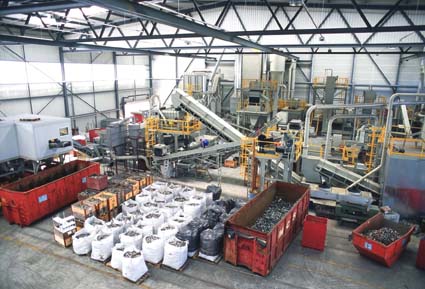|
Many people immediately think of computers when the words “electronic waste” are mentioned. After all, by the time you have learnt to use a computer effectively, the operating system has become obsolete and it is time to think of buying a newer, even faster system! But according to Lorenz Hilty, the Head of Empa’s Technology and Society Laboratory in St. Gall, even simple household equipment such as a coffee machine or vacuum cleaner contains an increasing amount of electronics. In Switzerland, about ten kilos of electronic waste is generated annually per head on average. Worldwide, the yearly sales of electronic goods are estimated to be 35 million tons. “In addition to harmful products, electronic waste contains valuable raw materials such as precious metals and other scarce substances,” Prof. Hilty informed the audience during his presentation. In a laptop computer, for example, there is about a gram of gold. This does not sound like much, but to produce the same quantity from a gold mine involves digging out and processing about one ton of ore. The primary challenge faced when dealing with electronic waste lies therefore not in disposal but rather in finding ways of recovering the valuable basic materials it contains.
Successful Swiss model
Yvonne Vögeli, from the BUWAL, the Swiss Federal Agency for the Environment, Forests and Landscape, reported on the Swiss recycling model for electronic waste. In Switzerland, legislation covering the disposal of electronic waste (VREG) has been in force since 1998. This stipulates that electrical and electronic equipment may not be disposed of with household waste. The aim of these regulations is to reduce the amount of problematic material being delivered to waste incineration plants and to encourage the recovery of recyclable metals. With effect from January 1st 2005 the list covered by the legislation was expanded and all sales outlets were obliged to take back old electronic equipment free of charge. This collection and recycling system, which covers the whole country, is financed by a prepaid recycling charge levied on new equipment introduced on a voluntary basis by the electronics branch. According to Yvonne Vögeli collection rates are significantly higher in Switzerland than in other European countries. She attributes this to, amongst other factors, the successful interplay between regulation and voluntary implementation and the fact that the system in use is simple and consumer-friendly.
Backyard recycling in developing countries
The export of electronic waste from Switzerland is subject to permission from the BUWAL, the aim being to prevent unregulated dumping abroad. However developing countries suffer not only from the effects of illegally imported electronic waste – countries such as India and China also produce enormous quantities of waste themselves, a consequence of the very rapid growth of their economies.
|


